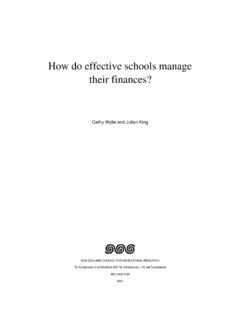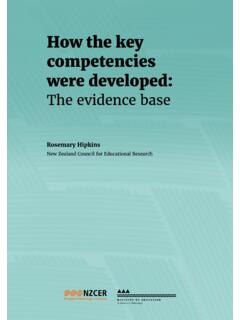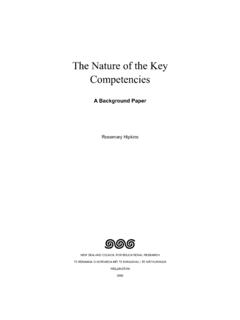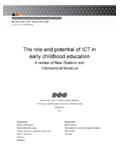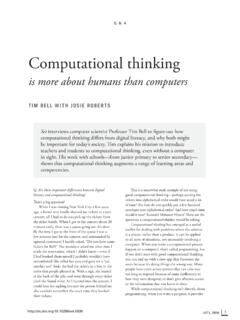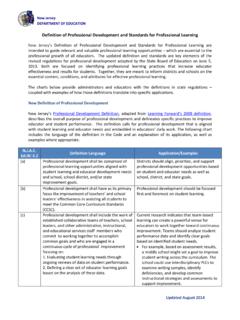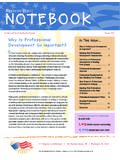Transcription of How do effective schools manage their finances?
1 How do effective schools managetheir finances? Cathy Wylie and Julian KingNEW ZEALAND COUNCIL FOR EDUCATIONAL RESEARCHTE R NANGA O AOTEAROA M TE RANGAHAU I TE M TAURANGAWELLINGTON2004 New Zealand Council for Educational ResearchP O Box 3237 WellingtonNew Zealand NZCER, 2004 Distributed by NZCER Distribution ServicesP O Box 3237 WellingtonNew Zealand NZCERiTable of contentsExecutive summaryvKey pointsvTrends from financial reportsviFinancial managementviiFinancial challenges and pressuresixMain drivers of effective schools budget to this study1 Study funding and school responsibility for financial management5 Locally raised overview of schools9 Revenues9 Secondary schools9 Primary schools10 Costs12 Secondary schools12 Primary analysis of expenditure patterns15 Teacher salaries15
2 Secondary schools15 Primary schools16 Professional development17 Secondary schools17 Primary schools17 Professional development by decile and roll size18 Support staff salaries20 Secondary schools20 Primary schools20 Support staff salaries by decile and roll size21 Property management22 Secondary schools22 Primary schools22 Property management costs by decile and roll size23 Depreciation23 Secondary schools23 NZCERiiPrimary of schools financial wellbeing25 Surplus/deficit25 Secondary schools25 Primary schools27 Secondary schools29 Primary schools31 Locally raised decisionmaking33 Board-principal relations and roles33 Composing the annual budget36 Priority setting37 Staff participation in budget formation38 Operation of school cost-centres40 Board perceptions of budget priorities41 Discretionary spending42 Current year s and financial health45 Primary schools45 Secondary value placed on teaching staff49 Use of operational funding for revenue53 Increasing roll numbers53 Contestable government funds53 Parental donations54 Primary
3 Schools54 Secondary schools54 Parent-Teacher associations54 Other sources55 Community trusts and local businesses55 International students57 Could effective schools rely on government grants alone?57 Primary schools57 Secondary finances59 Pressure areas60 Property62 ICT63 Depreciation64 Reserves and borrowing65 Surprises66On the back burner68 main drivers of effective schools budget decisions69 Identifying the need for programme change and resourcing it70 Conclusions for other schools and government policy71 Other schools71 Government policy72 TablesTable 1 Teacher salary expenditures secondary schools , 200316 Table 2 Teacher salary expenditures primary schools .
4 2003*16 FiguresFigure 1 Secondary school revenues, 200310 Figure 2 Proportionate breakdown of secondary school revenues, 200310 Figure 3 Primary school revenues, 2003*11 Figure 4 Proportionate breakdown of primary school revenues, 2003*12 Figure 5 Secondary school expenditures, 200313 Figure 6 Proportionate breakdown of secondary school expenditures, 200313 Figure 7 Primary school expenditures, 2003*14 Figure 8 Proportionate breakdown of primary school expenditures, 2003*14 Figure 9 Teacher development as a percentage of locally managed expenditure, secondaryschools, 2000 200317 Figure 10 Professional development as a percentage of locally managed expenditure,primary schools , 2000 200318 Figure 11 Professional development as a percentage of locally managed expenditure bydecile for secondary schools , 2000 200319 Figure 12 Professional development as a percentage of locally managed expenditure bydecile for primary schools .
5 2000 200319 Figure 13 Support staff salary costs as a percentage of locally managed expenditure,secondary schools , 2000 200320 Figure 14 Support staff salary costs as a percentage of locally managed expenditure,primary schools , 2000 200321 NZCERivFigure 15 Property management as a percentage of locally managed expenditure,secondary schools , 2000 200322 Figure 16 Property management as a percentage of locally managed expenditure, primaryschools, 2000 200323 Figure 17 Depreciation as a percentage of locally managed expenditure, secondary schools ,2000 200324 Figure 18 Depreciation as a percentage of locally managed expenditure, primary schools ,2000 200324 Figure 19 Surplus/deficit as a percentage of locally managed expenditure, secondaryschools, 2000 200325 Figure 20 Surplus/deficit per student, secondary schools , 2000 200326 Figure 21 Surplus/deficit per student with depreciation excluded, secondary schools .
6 2000 200327 Figure 22 Surplus/deficit as a percentage of locally managed expenditure, primary schools ,2000 200328 Figure 23 Surplus/deficit per student, primary schools , 2000 200328 Figure 24 Surplus/deficit per student with depreciation excluded, primary schools ,2000 200329 Figure 25 Working capital as a percentage of locally managed budget, secondary schools ,2000 200330 Figure 26 Working capital per student, secondary schools , 2000 200330 Figure 27 Working capital as a percentage of locally managed budget, primary schools ,2000 200331 Figure 28 Working capital per student, primary schools , 2000 200331 AppendicesAppendix 1:Interview questions for principals and board members75 NZCERvExecutive summaryKey pointsThis 3-year study of 18 effective New Zealand schools is funded by the NZ school Trustees Association.
7 The schools provide a range of location, roll size, and socio-economic decile. Thestudy focuses on financial management, to gain some real insight into funding decisions and thefactors that influence those decisions, and the use of government operational funding and locallyraised funds to meet their students needs. Finding out what is needed to accomplish this providesvaluable pointers to the adequacy of school findings from the first year of the study, about the 18 effective schools financialdecisionmaking are: They had robust systems of budget development and monitoring.
8 school boards andmanagement worked well together within shared frameworks created by their strategicplanning. The schools ran on thin margins in their budgets and therefore needed to take a conservativeapproach to financial management and programme changes. They focused money left after meeting essential running costs to annual goals derived fromtheir strategic plan priorities, and monitored spending very carefully. Working capital was important in these schools to provide a buffer for things that could notbe anticipated and to ensure they could maintain programmes in the short-term if rollsdropped.
9 Rolls are key to schools financial health. Only three of the nine primary schools in the studyhad ideal roll profiles. Small secondary schools faced issues of being able to provide asufficient range of courses, and large secondary schools on limited sites, issues ofovercrowding. All the schools employed teachers above their staffing entitlement. This cost them on averagearound a third of their operation grant. Other big cost areas were property maintenance,support staff, and ICT.
10 While spending on other areas showed some fluctuation over time, spending on professionaldevelopment remained fairly consistent, between 2 3 percent of operation grants. NZCERvi These effective schools valued their staff, and gave as much priority as they could toproviding supportive work conditions, and avoiding the need for redundancies. Allowing for depreciation to replace assets has become more significant to school financesbecause of increased school spending on ICT. Good administration staff were seen as essential to good financial management.
